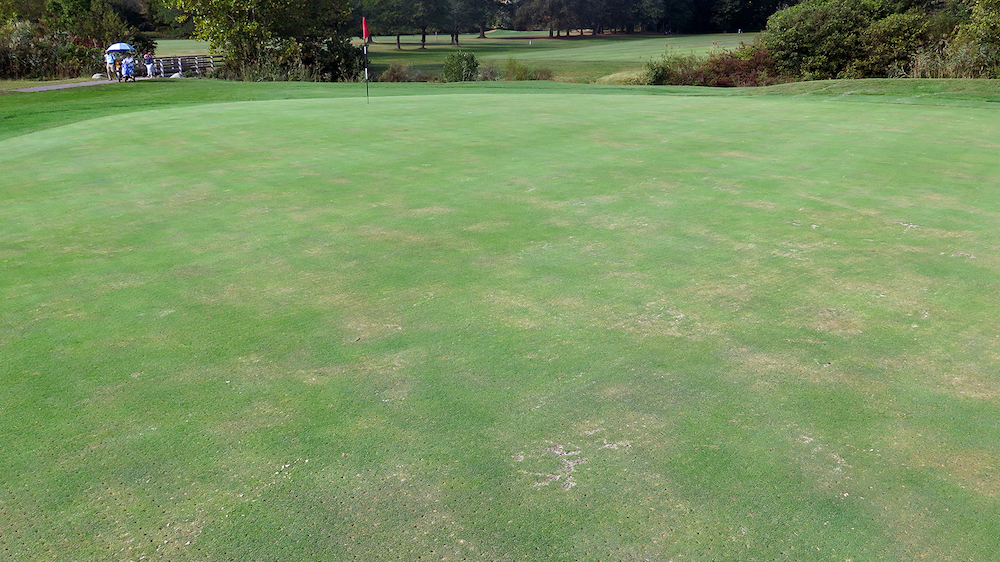FAYETTEVILLE, Ark. — Many golf course managers in Arkansas have putting greens that suffer from a problem called “localized dry spot,” patches of dying or dead grass. Turfgrass scientists with the Arkansas Agricultural Experiment Station are narrowing in on how best to deal with it.
Their work could also help homeowners, lawn care professionals and other sports field and court managers keep their grass in tip-top shape.
Mike Richardson, professor of horticulture with the experiment station, says putting greens built to United States Golf Association standards with 12-inch-deep sand root zones can develop hydrophobic areas that shed water instead of absorbing it to replenish the roots.
In addition to research on various wetting agents — surfactants that decrease water surface tension to help the water movement, retention, and uniformity in the water-resistant soil, experiment station scientists are also studying how hydrophobicity forms on these sand-based soils.
The Arkansas Agricultural Experiment Station is the research arm of the University of Arkansas System Division of Agriculture.
To get to the root of the matter, Daniel O’Brien, a Ph.D. horticulture student at the University of Arkansas, is working with experiment station scientists to learn more about what happens in sand-based putting greens when turfgrasses are under moisture stress.
O’Brien is also comparing application strategies for six widely used wetting agents.
The six different products being tested include Cleanse, Distance, Dispatch, Magnus, PBS150, and TriCure. The experiment included six treatments:
- Single application at the label rate
- Single application at twice the label rate
- Monthly applications at the label rate
- Monthly applications at half the label rate
- Repeated applications every two months at the label rate
- Untreated control with no application
O’Brien plans to share the results from his current study on application schedules of the wetting agents in November.
This work follows a two-year study that provided clarity on products marketed as “penetrants” and “retainers.”
‘Penetrants’ vs. ‘retainers’
Starting in 2017, Arkansas Agricultural Experiment Station turfgrass researchers led by Doug Karcher looked at wetting products marketed as “penetrants” and “retainers.” Notably, wetting agents do not go through the same federal registration and labeling process as herbicides, fungicides, or insecticides, resulting in less research data about what they are and how they work. In the absence of such data, marketing terminology and anecdotal evidence have been used instead. The study was supported by the Golf Course Superintendents Association of America. Karcher is now the horticulture and crop science department chair at The Ohio State University.
Lab studies at the University of Missouri showed some differences between how penetrants and retainers affect the shape of water droplets; however, the Arkansas Agricultural Experiment Station’s work concluded that it didn’t make much difference on the putting green.
“While differences may show up in the lab, they are not showing up in the complex biological system that is a putting green root zone,” O’Brien said. “The effects of penetrants and retainers are measurable. They are different from untreated control plots where no wetting agent is applied. However, the effects aren’t necessarily different from one category of wetting agent to another, be that penetrant or retainer.”
Hydrophobicity — refining the focus
Organic compounds in the root zone have long been understood to play a major role in the hydrophobic sandy soil that leads to localized dry spot. The small surface area of sand particles and intensive management practices for putting greens make this especially problematic in putting greens.
Turfgrass scientists have shown in studies going back to the 1970s that organic compounds accumulate and coat the small surface area of sand particles in the root zone to create hydrophobic sandy soil. Microbial activity has traditionally been seen as the major drive for hydrophobicity in the overall, bulk root zone.
O’Brien said the Arkansas Agricultural Experiment Station’s current study seeks to understand more about microbial activity in two important ways. First, in terms of how it leads to the hydrophobicity development — the byproducts of microbes ending up as coatings on sand particles. Second, how microbes may be breaking down and degrading the wetting agents after they have been applied.
New research out of Europe suggests that refining the focus to the rhizosphere — the narrow soil zone directly adjacent to plant roots where critical plant, soil and water interactions take place — may provide new insights into localized dry spot, O’Brien said.
Richardson and O’Brien are paying close attention to the rhizosphere for clues to what drives those microbes that appear to create hydrophobic soil. O’Brien said scientific literature on the matter, including studies on other plants besides turfgrass, points to the idea that hydrophobic organic compounds may be exuded by roots when the plants are under stress. Initially, the root exudates serve the purpose of helping preserve water within the plant.
O’Brien said that as the soil dries out to a critical level, the exudate compounds may become hydrophobic barriers to the rhizosphere. They make re-wetting of plants more difficult, even when moisture returns to the bulk soil. But more research is needed, O’Brien said.
Another key point about wetting agents, O’Brien said, is that they do not eliminate localized dry spots but rather mitigate or lessen their effects, so they often need to be reapplied.
“The point where an applied wetting agent is no longer effective, and the localized dry spot symptoms become pronounced, needs to be better understood,” O’Brien said. “Again, a lot is attributed to microbes. But what drives that activity? We want to understand when to reapply wetting agents and how much to reapply. That is another cornerstone of this current study.”
Looking ahead
As part of his investigation, O’Brien measured the volumetric water content in the root zone and turfgrass quality on the surface. He said water content continues to be a convenient measurement to acquire using portable moisture meters and he has documented “a lot of meaningful differences over the years.”
But as with any measurement, O’Brien said there is a limitation to what the moisture content levels can tell them. When they see similar root zone moisture levels corresponding to drastic differences in turfgrass quality, they want to explore what is behind it.
“That’s one of the things that makes wetting agent work exciting,” O’Brien said. “There are a lot of unexplored territories to venture into, and the rhizosphere is certainly included in that. There is a lot more work to be done here but narrowing the focus and discussion of hydrophobicity to the rhizosphere seems to hold a lot of promise.”


